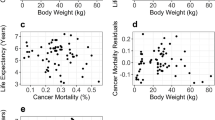Abstract
Replicated within-family selection for increased voluntary wheel running in outbred house mice (Mus domesticus; Hsd:ICR strain) was applied with four high-selected and four control lines (10 families/line). Mice were housed individually with access to activity wheels for a period of 6 days, and selection was based on the mean number of revolutions run on days 5 and 6. Prior to selection, heritabilities of mean revolutions run per day (rev/day), average running velocity (rpm), and number of minutes during which any activity occurred (min/day) were estimated by midparent–offspring regression. Heritabilities were 0.18, 0.28, and 0.14, respectively; the estimate for min/day did not differ significantly from zero. Ten generations of selection for increased rev/day resulted in an average 75% increase in activity in the four selected lines, as compared with control lines. Realized heritability averaged 0.19 (range, 0.12–0.24 for the high-activity lines), or 0.28 when adjusted for within-family selection. Rev/day increased mainly through changes in rpm rather than min/day. These lines will be studied for correlated responses in exercise physiology capacities and will be made available to other researchers on request.
Similar content being viewed by others
REFERENCES
Blizard, D. A. (1983). Sex differences in running-wheel behaviour in the rat: The inductive and activational effects of gonadal hormones. Anim. Behav. 31:378–384.
Bruell, J. H. (1964). Heterotic inheritance of wheel running in mice. J. Comp. Physiol. Psych. 58:159–163.
Bult, A., Van der Zee, E. A., Compaan, J. C., and Lynch, C. B. (1992). Differences in the number of arginine-vasopressin-immunoreactive neurons exist in the suprachiasmatic nuclei of house mice selected for differences in nest-building behavior. Brain Res. 578:335–338.
Bult, A., Hiestand, L., Van der Zee, E. A., and Lynch, C. B. (1993). Circadian rhythms differ between selected mouse lines: A model to study the role of vasopressin neurons in the suprachiasmatic nuclei. Brain Res. Bull. 32:623–627.
Collier, G., and Leshner, A. I. (1967). An invariant in mouse running wheel behavior. Psychon. Sci. 8:9–10.
DeFries, J. C., Gervais, M. C., and Thomas, E. A. (1978). Response to 30 generations of selection for open-field activity in laboratory mice. Behav. Genet. 8:3–13.
DeFries, J. C., Wilson, J. R., and McClearn, G. E. (1970). Open-field behavior in mice: Selection response and situational generality. Behav. Genet. 1:195–211.
Dewsbury, D. A. (1980). Wheel-running behavior in 12 species of muroid rodents. Behav. Process. 6:271–280.
Dohm, M. R. (1994). Quantitative Genetics of Locomotor Performance and Physiology in House Mice (Mus domesticus), Ph.D. dissertation, University of Wisconsin—Madison.
Dohm, M. R., Hayes, J. P., and Garland, T., Jr. (1996). Quantitative genetics of sprint running speed and swimming endurance in laboratory house mice (Mus domesticus). Evolution 50:1688–1701.
Dohm, M. R., Richardson, C. S., and Garland, T., Jr. (1994). Exercise physiology of wild and random-bred laboratory house mice and their reciprocal hybrids. Am. J. Physiol. 267:R1098–R1108.
Falconer, D. S. (1963). Quantitative inheritance. In Burdette, W. J. (ed.), Methodology in Mammalian Genetics, Holden-Day, San Francisco.
Falconer, D. S. (1973). Replicated selection for body weight in mice. Genet. Res. Cambr. 22:291–321.
Friedman, W. A., Garland, T., Jr., and Dohm, M. R. (1992). Individual variation in locomotor behavior and maximal oxygen consumption in mice. Physiol. Behav. 52:97–104.
Garland, T., Jr., and Carter, P. A. (1994). Evolutionary physiology. Annu. Rev. Physiol. 56:579–621.
Harpur, R. P. (1980). The rat as a model for physical fitness studies. Comp. Biochem. Physiol. 66A:553–574.
Hauschka, T. S., and Mirand, E. A. (1973). The “breeder: HA(ICR)” Swiss mouse, a multipurpose stock selected for fecundity. In Murphy, G. P., Pressman, D., and Mirand, E. A. (eds.), Perspectives in Cancer Research and Treatment, Alan R. Riss, New York.
Hayes, J. P., and Garland, T., Jr. (1995). The evolution of endothermy: Testing the aerobic capacity model. Evolution 49:836–847.
Hill, W. G. (1972). Estimation of realized heritabilities from selection experiments. I. Divergent selection. Biometrics 29:747–765.
Hill, W. G., and Rasbash, J. (1986). Models of long term artificial selection in finite population. Genet. Res. Cambr. 48:41–50.
Holloszy, J. O. (1993). Exercise increases average longevity of female rats despite increased food intake and no growth retardation. J. Geront. 48:B97–B100.
Lambert, M. I., and Noakes, T. D. (1990). Spontaneous running increases VO2max and running performance in rats. J. Appl. Physiol. 68:400–403.
Lynch, C. B. (1980). Response to divergent selection for nesting behavior in Mus musculus. Genetics 96:757–765.
Lynch, C. B. (1994). Evolutionary inferences from genetic analyses of cold adaptation in laboratory and wild populations of the house mouse. In Boake, C. R. B. (ed.), Quantitative Genetic Studies of Behavioral Evolution, University of Chicago Press, Chicago.
Mather, J. G. (1981). Wheel-running activity: A new interpretation. Mamm. Rev. 11:41–51.
Montgomery, D. C., and Peck, E. A. (1992). Introduction to Linear Regression Analysis, Wiley, New York.
Oliverio, A., Castellano, C., and Messeri, P. (1972). Genetic analysis of avoidance, maze, and wheel-running behaviors in the mouse. J. Comp. Phys. Psych. 79:459–473.
Perrigo, G., and Bronson, F. H. (1985). Sex differences in the energy allocation strategies of house mice. Behav. Ecol. Sociobiol. 17:297–302.
Rodnick, K. J., Reaven, G. M., Haskell, W. L., Sims, C. R., and Mondon, C. E. (1989). Variations in running activity and enzymatic adaptations in voluntary running rats. J. Appl. Physiol. 66:1250–1257.
Rundquist, E. A. (1933). Inheritance of spontaneous activity in rats. J. Comp. Physiol. Psych. 16:415–438.
Swallow, J. G., Garland, T., Jr., Carter, P. A., Zhan, W.-Z., and Sieck, G. C. (1998). Effects of voluntary activity and genetic selection on aerobic capacity in house mice (Mus domesticus). J. Appl. Physiol. 84:69–76.
Walker, C., and Byers, J. A. (1991). Heritability of locomotor play in house mice, Mus domesticus. Anim. Behav. 42:891–897.
Author information
Authors and Affiliations
Rights and permissions
About this article
Cite this article
Swallow, J.G., Carter, P.A. & Garland, T. Artificial Selection for Increased Wheel-Running Behavior in House Mice. Behav Genet 28, 227–237 (1998). https://doi.org/10.1023/A:1021479331779
Issue Date:
DOI: https://doi.org/10.1023/A:1021479331779




